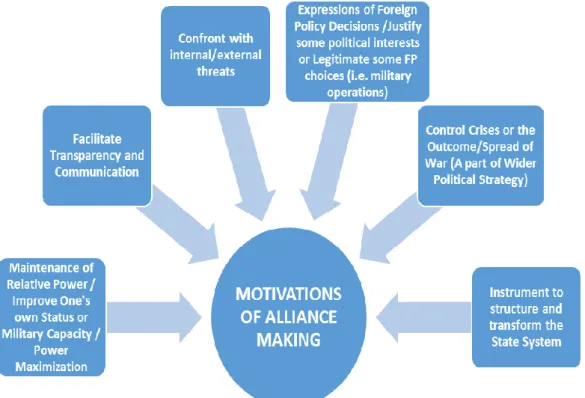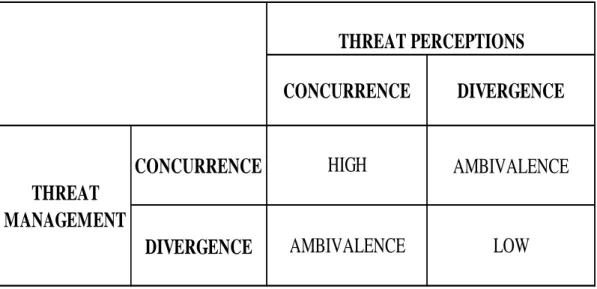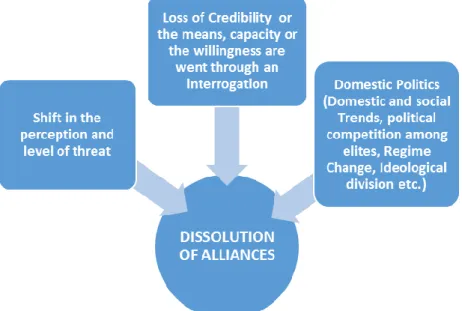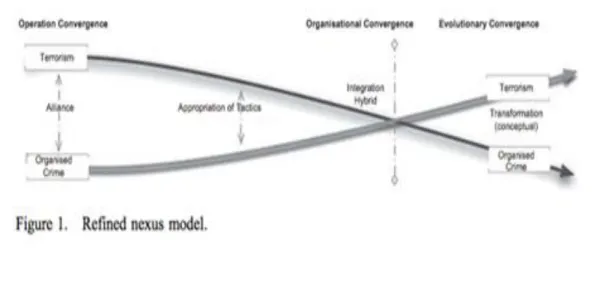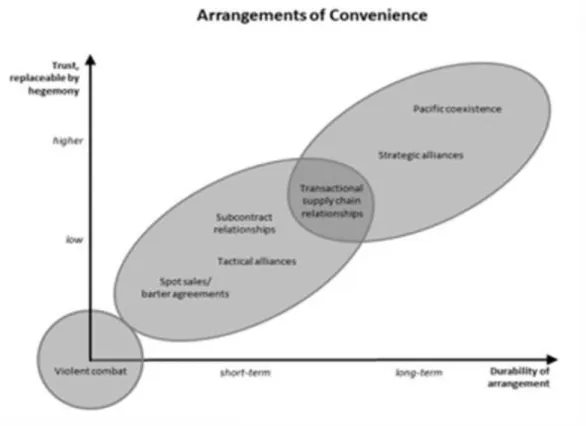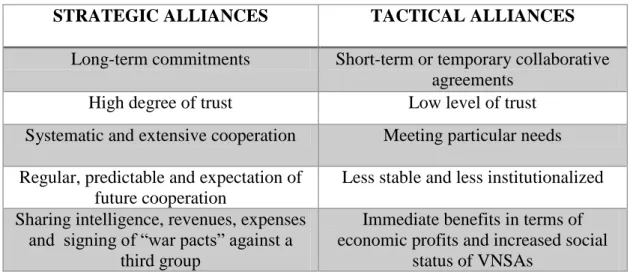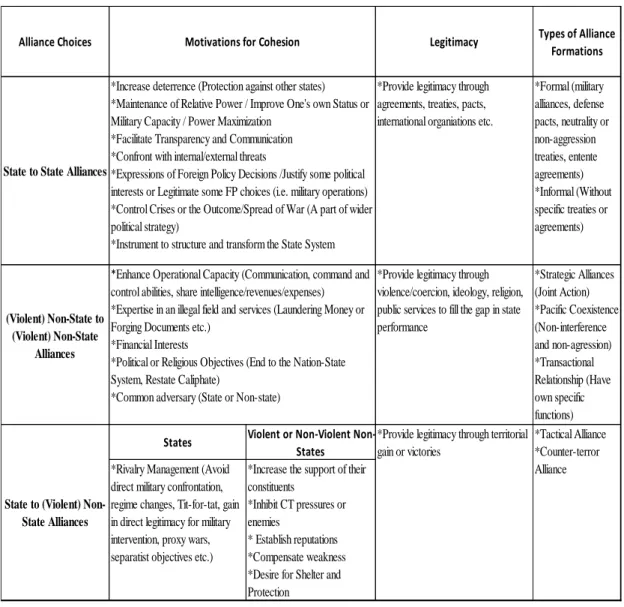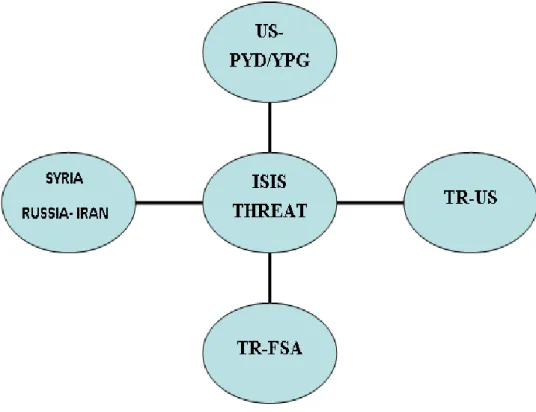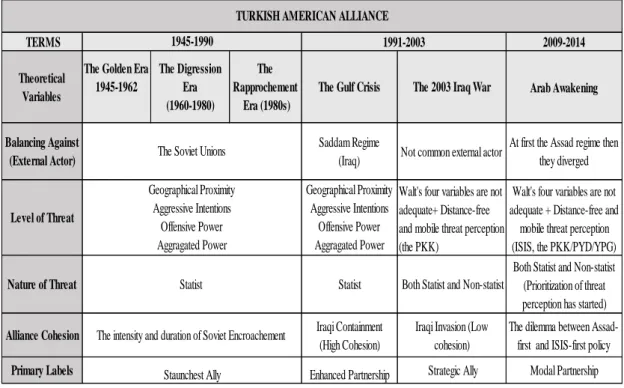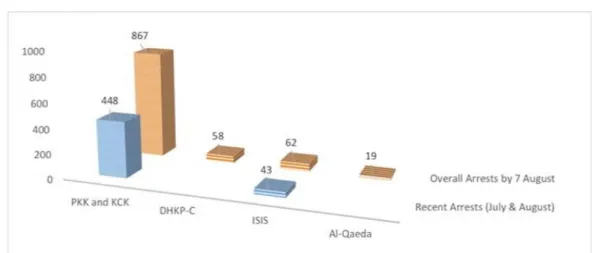THE IMPACTS OF NON-STATIST THREATS ON ALLIANCE COHESION: TURKISH-AMERICAN CASE
A Master’s Thesis
by
YASEMIN YILMAZ
Department of International Relations İhsan Doğramacı Bilkent University
Ankara July 2017 Y A SE MI N Y ILMA Z T H E I MPA C TS O F N O N -ST A TIST T H R EA TS O N A L LIAN C E C O H ES IO N : TU R K ISH -A MER IC A N C A SE B ilken t U ni v er si ty 20 17
THE IMPACTS OF NON-STATIST THREATS ON ALLIANCE COHESION: TURKISH-AMERICAN CASE
Graduate School of Economics and Social Sciences of
İhsan Doğramacı Bilkent University
by
YASEMIN YILMAZ
In Partial Fulfilment of the Requirements for the Degree of MASTER OF ARTS
THE DEPARTMENT OF INTERNATIONAL RELATIONS İHSAN DOĞRAMACI BİLKENT UNIVERSITY
ANKARA July 2017
iii
ABSTRACT
THE IMPACTS OF NON-STATIST THREATS ON ALLIANCE COHESION: TURKISH-AMERICAN CASE
Yılmaz, Yasemin
M.A., Department of International Relations Supervisor: Prof. Dr. Ersel Aydınlı
July 2017
There is a complex web of alliances formed against a range of actors from states to NSAs and diversified agenda of threats from statist to non-statist. This thesis aims to explore the changing nature of alliances in light of the increased role of VNSAs by challenging Walt’s balance of threat theory. The Turkish-American alliance is selected to demonstrate non-statist threats’ impacts on alliance cohesion. This thesis argues that concurrence/divergence of threat perception and threat management between two allies affects the degree of cohesion as high or low. In this regard, I aim to find an answer to this research question: How have the evolving Turkish and American perceptions of the PKK/PYD affected the alliance cohesion between Turkey and the US? I will analyze the historical period from 1952 to 2017, dividedby the Kobane siege, using a single-longitudinal case study method. I observe that certain Kurdish entities have become the “Achilles heel” of this partnership and
iv
constitute the major challenge for the cohesiveness of the alliance. The rise of Kurdish capabilities in the region against ISIS has led the US to ally with the PYD/YPG as the ground force of choice. This choice has forced apart the two allies by decreasing the cohesiveness of the alliance and given way to a kind of “veiled trilateral relationship” among the US, Turkey and the PYD/YPG. This outcome demonstrates how “diverse-actored” alliances can be formed simultaneously to balance against different external threats contrary to the “state to state” origin of BoT theory.
Keywords: Alliance cohesion, Balance-of-Threat Theory, Non-statist threats,
Turkey, US,
iii
ÖZET
DEVLET-DIŞI TEHDİTLERİN İTTİFAKIN UYUMUNA (KOHEZYONUNA) ETKİSİ: TÜRK-AMERİKAN İTTİFAKI
Yılmaz, Yasemin
Yüksek Lisans, Uluslararası İlişkiler Bölümü Tez Danışmanı: Prof. Dr. Ersel Aydınlı
Temmuz 2017
Günümüzde devletlerden devlet-dışı örgütlere kadar uzanan bir dizi aktöre karşı oluşturulmuş karmaşık ittifak ağları ve bu aktörlerden kaynaklanan tehditler mevcuttur. Bu tez, şiddet kullanan devlet dışı örgütlerin giderek artan rolü ışığında günümüzdeki ittifakların değişen doğasını Walt’ın “tehdit dengesi” teorisi çerçevesinde araştırmayı amaçlamaktadır. Devlet-dışı tehditlerin ittifakın kohezyonuna (uyumuna) etkisini göstermek amacıyla Türk-Amerikan ittifakı vaka olarak analiz edilmiştir. Bu tez, müttefiklerin kendi aralarında tehdit algılamasının ve onun yönetiminin muvafakat (uyuşma)/ayrışmasına bağlı olarak ittifak uyumunun
iv
yüksek ya da düşük olacağını iddia etmektedir. Bu bağlamda, aşağıda belirtilen araştırma sorusuna cevap bulunulması amaçlanmıştır: Türkiye ve ABD’nin zaman içinde evrim geçiren PKK/PYD tehdit algılamaları, Türk-Amerikan ittifakının kohezyonunu (uyumunu) nasıl etkilemiştir? 1957’den 2017’ye kadar uzanan tarihi dönem, Kobani kuşatması dönüm noktası olarak seçilecek şekilde, tek-boylamsalvaka metodu kullanılarak analiz edilmiştir. Bu süreçte bazı Kürt gruplarının, zaman içinde Türk-Amerikan ittifakının “Aşil Tendon” u haline geldiği ve ittifakın uyumunun önündeki en büyük zorluk olduğu gözlemlenmiştir. IŞİD’e karşı bazı Kürt gruplarının savaşma yeteneğinin ve kapasitesinin artması, ABD’yi karada savaşan bir güç olarak PYD/YPG’yi seçmeye yönlendirmiştir. Bu seçim, iki müttefikin (Amerika ve Türkiye) ittifakının kohezyonunu azaltarak ittifakın güçten düşmesini sağlamış ve üç taraf arasında (Amerika-Türkiye-PYD/YPG) “örtülü üçlü bir ilişkinin” doğmasına yol açmıştır. Bu sonuç, farklı dış tehditleri dengelemek maksadıyla Walt’ın “devlet-devlet” unsurlu ittifak teorisinin aksine, bugünün konjonktüründe “çeşitli-aktörlü” ittifakların da eş zamanlı olarak oluşturulabileceğini göstermiştir.
Anahtar Kelimeler: ABD, Devlet-dışı tehditler, İttifak kohezyonu, Tehdit dengesi
v
ACKNOWLEDGEMENTS
First and foremost, I would like to express my sincerest gratitude to my supervisor Prof. Dr. Ersel Aydınlı for his precious guidance, patience and unwavering personal and academic support not only throughout my thesis but also during my master degree at Bilkent University. Whenever I face a trouble spot or have questions about my research, he led me to the right source and perspective. This thesis would not have been possible without his mentorship and constructive comments.
I am grateful also to my thesis committee members Assist. Prof. Dr. Nihat Ali Özcan and Assist. Prof. Dr. İ. Özgür Özdamar for their insightful evaluations and constructive criticism. I also thank Gonca Biltekin and Şermin Pehlivantürk for their warm attitude and continuous encouragement during my graduate studies and sharing their academic knowledge whenever I needed.
I would like to thank my dearest friends Elif Akkaya, Yeliz Gökçer, Ülkü Duman Esra Buran Öztürk, and Meltem Özyıldız for their long-term friendship and endless support throughout my undergraduate and graduate studies. I would like to express my gratitude to Begüm C. Canpolat and Nurten Çevik for being my companion while writing this thesis. I am indebted also to the deceased Nimet Kaya for her kind-heartedness and helpfulness throughout my years of study at Bilkent University. Finally, my special thanks go to my beloved father Orhan Yılmaz and beloved mother Selvi Yılmaz for their continuous encouragement, support and
self-vi
abnegation throughout my whole life. I owe all I have to their dedication and patience.
vii TABLE OF CONTENTS ABSTRACT………...i ÖZET………...iii ACKNOWLEDGEMENTS………...v TABLE OF CONTENTS………...vii LIST OF ABBREVIATIONS………xii LIST OF TABLES………xiv LIST OF FIGURES………...xv
CHAPTER 1: INTRODUCTION AND METHODOLOGY………...1
1.1. Motivations for Alliance Making………..2
1.2. Defining the Gap and Identifying the Problematique in Alliance Theory 1.2.1. A need for Non-statist Explanation in BoT Theory………...4
1.2.2. Linkage between Threat and Alliance Cohesion ………..8
1.3. Case Selection……….12
1.4. Outlines of Chapter……….14
1.5. Methodology………...16
1.5.1 Research Design………17
1.5.2. Single Longitudinal Case Study………...24
1.5.3. Data Gathering and Analysis………28
CHAPTER 2: LITERATURE REVIEW………31
2.1. Alliance Definition 2.1.1. Narrow and Wide Definitions………...32
viii
2.1.2. Formal and Informal Alliances……….35
2.2. The Significance of Forming an Alliance………37
2.3. The Dissolution of Alliances………...39
2.4. Typologies of Alliance Choices 2.4.1. State-Based Concepts and Traditional Alliance Theories in Pre-Cold War Period………..41
2.4.2. The Concept of Alliance in Post-Cold War Period………...44
2.4.2.1. New Alliance Concepts Focusing on Domestic Elements….45 2.4.2.2. Balance of Interest Theory……….47
2.4.2.3. Alliance Shelter Theory……….48
2.4.2.4. State-Centric Alliance Theory………...48
2.4.2.5. Tethering Alliance……….49
2.4.3. Non-State Actor Based Alliance Concepts 2.4.3.1. Alliance between VNSAs………..51
2.4.3.2. Miscellaneous Alliances 2.4.3.2.1. State to VNSA based Alliances………..57
2.5. Threat Perception………63
2.5.1. Variables of Threat Perception……….65
2.5.2. Balance of Threat Theory……….67
2.5.2.1 Main Assumptions of BoT theory………..69
2.5.2.1.1. To Balance or to Bandwagon………..70
2.5.2.1.2. Level of Threat………72
2.5.2.1.3. Critique and Gaps in Balance of Threat…………..73
CHAPTER 3: CONVENTIONAL ALLIANCE RELATIONS BETWEEN TURKEY AND THE US………78
3.1. Balance of Threat: Theoretical and Conceptual Explanations between 1945 and 1990………78
3.1.1. Golden Age - Honeymoon Period (1945-1960) ………..79
ix
3.1.3. New Rapprochement Era (1980s)……….92
3.2. Balance of Threat: Theoretical and Conceptual Explanations between 1990 and 2003………93
3.2.1. Turkish-American Alliance between 1990 and 2003………...95
3.2.1.1. From Enhanced Partnership to Strategic Partnership………97
3.2.1.2. Regional Security Issues………99
3.2.1.3. Iraqi Quagmire (Gulf Crisis)………...100
3.2.1.4. Kurdish Question………...103
3.2.1.5. Ethno-national Conflicts in the 1990s……….106
3.2.2. A New Baulk in the TR-US Alliance: Post-September 11 Period….107 3.2.2.1. Alliance in Tatters: March 1st Crisis in 2003………...108
3.3. Balance of Threat: Theoretical and Conceptual Explanations between 2009 and 2014………..112
3.3.1. Implications of Post-Arab Uprising on the US-TR Alliance………..113
3.4. The Historical Building Blocks of the US-Kurdish Alliance………118
CHAPTER 4: DEEPENING DISCORD BETWEEN TWO LONGSTANDING ALLIES: TURKEY AND THE US ………124
4.1. Turning Point of a Long-standing Alliance 4.1.1. The Siege of Kobane (Ain-al-Arab) and its Liberation………..126
4.2. Three-pronged Threat: PKK/PYD/YPG 4.2.1. Two Allies’ Diverging Primary Threat Perceptions………...131
4.2.2. The New Sister Organization of the PKK/PYD: The YPG 4.2.2.1. Identification of the YPG……….133
4.2.2.2. The Critical Role of the YPG in Kobane and Tal-Abyad…135 4.2.3. Turkish Perceptions of the PYD/YPG Threat 4.2.3.1. Turkey’s Justifications about the PYD/YPG………...136
4.2.3.2. Concrete Evidence for Turkish Perception of the PYD/YPG……….139
4.2.4. Echoes of the Three-Pronged Threat Perception………141
4.2.5. US Decision Makers’ Threat Evaluation and Ally Preference……...143
4.3. An Odd De Facto Alliance: The US and the PYD/YPG 4.3.1. Actual Side of the US-PYD/YPG Relations………...146
x
4.3.2. Verbal Side of the US-PYD/YPG Relations………..149 4.4. Turkey’s Reactions to the US-PYD/YPG Alliance
4.4.1. Actual Reactions to the US-PYD/YPG Alliance………....150 4.4.2. Verbal Reactions the US-PYD/YPG Alliance………....151 4.5. Bilateral Efforts to Mend the Fences
4.5.1. First Bilateral Effort: “Train-and-Equip Program” in Syria………...152 4.5.2. Second Bilateral Effort: Incirlik Agreement………...154 4.6. Trilateral Relations among Turkey, the US and the PYD/YPG………....156 4.7. The Erosion of Essential Trust in the TR-US Alliance: The 15 July Coup
Attempt……….157 4.8. Turkey’s Red Line: The Euphrates Shield Operation in Syria (August 2016-March 2017)……….161 4.9. Trump Administration: Ambiguous Future of Turkish-American Alliance….163
CHAPTER 5: BEFORE-AFTER ANALYSIS………168 5.1. Before Phase: From NATO to Kobane Siege
5.1.1. Concurrence of Threat Perception and Management
5.1.1.1. Sub-Phase: 1952-1990……….168 5.1.1.2. Second Sub-Phase: 1991 Gulf Crisis………...169 5.1.1.3. Third Sub-Phase: 1992-2014………...171 5.1.2. Rising Kurdish Power and Origin of Threat Differentiation among Allies
5.1.2.1. Threat Differentiation Regarding Iraqi Kurdish Entities….173 5.1.2.2. 2003 Iraq War: Divergence of Threat Perception and Threat Management………..175 5.1.2.3. 2009-2014 September: Threat Differentiation Regarding Syrian Kurdish Entities……….178 5.2. After Phase: From the Kobane Siege to 2017………...182 5.2.1. Syrian Kurds are on the Rise: Practical and Discursive Divergence..183 5.2.2. Turkish Policy vs. American Policy after the Kobane………...190 5.2.2.1. The Turkish Policy: Strategic, Long-term focused, Politicized………...190 5.2.2.2. The American Policy: Pragmatic, Short-term focused, Result-oriented….193
CHAPTER 6: CONCLUSION……….197 6.1. Concrete Observations on Turkish-American Alliance: Kurdish Power
xi
6.2. Balance of Threat Theory: Theoretical Observations on Turkish-American
Alliance……….202
6.3. Revision of BoT Theory: Walt’s Critique and Suggestions………..204
6.4. Policy Implications and Future Prospects……….207
xii
LIST OF ABREVIATIONS
BoT Balance of Threat
CENTCOM United States Central Command
DECA Defense and Economic Cooperation Agreement DHKP-C Revolutionary People’s Liberation Party-Front FARC Revolutionary Armed Forces of Colombia FETO Fethullah Gulen Terror Organization FSA Free Syrian Army
HDA Humanitarian Defense Abroad HDP People’s Democratic Party HPG People’s Defense Force
ISAF International Security Assistance Force ISIS (DAESH) Islamic State of Iraq and Syria
JDP (AKP) Justice and Development Party KCK Kurdistan Communities Union KDP Kurdistan Democratic Party KRG Kurdistan Regional Government NAG Non-State Armed Groups
NATO North Atlantic Treaty Organization
xiii OCG Organized Crime Groups ODS Operation Desert Storm OPC Operation Provide Comfort
PÇDK Kurdistan Democratic Solution Party PJAK Kurdistan Free Life Party
PKK Kurdistan Workers' Party
PMF Popular Mobilization Forces (Hashd al-Shaabi) PUK Patriotic Union of Kurdistan
PYD Democratic Union Party SDF Syrian Democratic Forces SNC Syrian National Council SOLI Sons of Liberty International TEV-DEM Movement for a Democratic Society USSR Union of Soviet Socialist Republics VNSA Violent Non-State Actor
WMD Weapon of Mass Destruction YPG People's Protection Units YPJ Women’s Protection Units
xiv
LIST OF TABLES
Table 1: Framework for measuring threat perceptions and threat
management………22
Table 2: Framework for the degree of alliance cohesion ………..24
Table 3: Strategic and tactical alliances………...57
Table 4a: Typologies of alliance choices and their features………..62
Table 4b: Typologies of alliance choices and their features………..63
Table 5: The summary of theoretical explanations from 1945 to 2014 September………...123
Table 6: The cohesion degree of the Turkish-American alliance based on threat perceptions and threat management in each era………...190
xv
LIST OF FIGURES
Figure 1: Motivations for alliance making based on the alliance literature…………3
Figure 2: Fundamental reasons for the dissolution of alliances………....40
Figure 3: Refined nexus model……….54
Figure 4: Arrangements of Convenience………..56
Figure 5: An example of “diverse-actored” alliance in the alliance formation…….76
Figure 6: Overall and recent arrests of several terrorists groups in Turkey………155
1
CHAPTER 1
INTRODUCTION AND METHODOLOGY
“It is impossible to speak about IR without referring to alliances; the two often
merge in all but name. For the same reason, it has always been difficult to say much that is peculiar to alliances on the plane of general analysis”1
“For how can Tyrants safely govern home,
unless abroad they purchase great alliance?”2
“We have no eternal allies, and we have no perpetual enemies. Our interests are eternal and perpetual, and those interests it is our duty to follow.”3
The above-mentioned three expressions regarding the gravity of alliances demonstrates the significant status of the concept of alliance and alignments throughout the history of humanity. The first statement takes place in the opening sentences of one of the theoretical seminal works of George Liska in his Nations in
Alliance. Liska (1962) attests to the significant status of alliance in the International
Relations literature. The same view is shared by George Modelski, who asserts that ‘alliance’ is among the “dozen or so key terms of International Relations” (Modelski, 1963: 773). The second quote, by Shakespeare, proves the relationship between a state’s political structure and its alliance policy, and finally the last one implies the
1
Liska, G. (1962). Nations in Alliance: The Limits of Interdependance. Johns Hopkins University Press, p.3.
2 William Shakespeare, Henry VI, Part III (c. 1591), Act III, scene 3, line 69.
3
This quotation belongs to Lord Palmerston, from remarks made in the House of Commons (Hansard’s Parliamentary Debates, 3d series, vol. 97, col. 122).
2
changing character of alliance relations between political entities in the sense that the only perpetual phenomenon is “interest” in alliance formation. Alliance is a comprehensive word which is used to imply many things, from limited cooperation to an institutionalized, NATO-like structure (Byman, 2006: 772). Thus, while some scholars generally use this term interchangeably with coalition, pact, bloc, or alignment, others make distinctions among them based on various criteria (Holsti, Hopmann and Sullivan, 1973: 3).
1.1. Motivations for Alliance Making
First of all, alliances are the central element of international cooperation, while at the same time showing the commitment level between states (Bennett, 1997: 846). The decision to form an alliance emanates from the need of maintaining or improving one’s own status in the global, regional or domestic arena. While some defensive realist scholars link states’ alliance motivations with the maintenance of relative power, on the other hand, offensive realists argue that state seek power maximization through alliance formation. As stated by George Liska (1962: 21), “alliances aim at maximizing gains and sharing liabilities”, thus, through alignment behavior, “power” can be a factor which states desire to obtain as a gain. When nation states tend to tie with each other via alliances, they at the same time tie their policy positions and adopt relevant policies accordingly knowing their partners’ next move or choice (Altfeld, 1984: 526). Thus, alliances are instruments in order to structure or transform the state system and to facilitate transparency and communication among partners (Liska, 1962: 12; Friedman, Bladen and Rosen, 1970: 20; Weitsman, 1997: 165). Secondly, states have several domestic and international options to confront with external or internal threats. While a nation can
3
respond to such threats with some creative measures such as domestic political reforms, foreign policy initiatives, and economic or political cooperation, alliances and internal mobilization are the two most frequently used instruments (Cooper, 2003: 309). Hence, alliances are used as the primary expression of foreign policy decisions (Beres, 1972: 702). Thirdly, the alliance concept is not only wielded to control a crisis or the outcome and the spread of war but is also used as a part of a wider political strategy in those kinds of conflicts (Rothstein, 1968: 53). Hence, as Weitsman claims, alliances are essential in International Relations both in theoretical and practical manner (Weitsman, 1997: 158).
4
1.2. Defining the Gap and Identifying the Problematique in Alliance Theory
1.2.1. A need for Non-statist Explanation in Balance of Threat Theory (BoT)
In order to comprehend the coalition and conflict dimensions in bilateral or multilateral relations between nation-states, scholars developed alliance theories. To date, the study of alliances has been elaborated with the explanations of realists and from the state-centric perspective. While defining the alliance concept, realists make systemic explanations that focus mainly on states’ relative status in the international system as the primary motivation for alignment (Miller and Toritsyn, 2005: 328). For instance, the typology delineating necessary terms for the concept of alliance identifies alliances as “comprised of states as members” and “having a fixed territorial jurisdiction” (Fedder, 1968: 80-81). Alliance concept has been developed with the contributions of realist and neo-realist scholars. The first attempts for alliance theories were started with Morgenthau’s (1948) and Waltz’s (1979) balance of power theory, then gained new dimensions with Walt’s balance of threat theory. These two traditional alliance theories come up with state-based concepts and overemphasized states’ role in alliance structure. Even the definition of the “alliance” was made by scholars adopting the afore-mentioned state-centric understanding. An important figure in alliance literature, Glenn Snyder, also argued for NSAs’ exclusion from the concept of alliance but he gave no reasonable explanation for his argument. The relevant literature focused only on the modification of the state-based alliance theories theoretically and there were several attempts to support these traditional theories empirically. There are plentiful studies elaborating on why and with whom states form alliances and why we witness a dissolution of alliance between states. Although some scholars criticized the overemphasis on nation states
5
in alliance literature, their suggestions did not go beyond states’ internal dynamics such as the role of national leaders, governments and executive bureaucracy in the formation and maintenance of an alliance. Moreover, some scholars come up with the ideas that small states have an idiosyncratic nature and should be analyzed differently than great power alliances. Schweller’s ‘Balance of Interest’ (1994), Bailes, Thayer and Thorhallsson’s ‘Alliance shelter’ (2016), and Cooper’s ‘State-centric alliance theory’ (2003) are some of the main examples of the modification attempts of old concepts in alliance literature(i.e. “bandwagoning” “jackal bandwagoning”) and traditional alliance theories.
However, this realist perspective to alliance concept should be streamlined from different angles: First of all, in contrast to previous alignment strategies made between states against traditional threat perceptions (i.e. Cold War threat atmosphere), post-Cold war alignment strategies between states focus mostly on transnational threats (i.e. terrorism, transnational organized crimes, human trafficking). More than ever, states perceive “non-statist threats” seriously and in an era of transnationalism the forms and dynamics of inter-state alliances against transnational threats have to take into consideration the changing nature of this threat perception. Secondly, new globalization dynamics have also affected the type of entities in alliance formation: Violent non-state actors (VNSAs)/Non-violent NSAs (NGOs, Multinational corporations (MNCs)). Among all NSAs, I will specifically and narrowly focus on VNSAs because they are rising actors which have gained a vital status in alliance formation with states or their counterparts against external threats. The abundance of state to VNSA relations and VNSAs’ competence in contrast to other NSAs requires a comprehensive analysis.
6
Security is at the heart of the concept of alliance and mainstream alliance theories, thus, states’ choosing of VNSAs as partners is to serve their security interests by countering external threats. Thus, I would like to focus on “security dimensions” of the alliance concept more than “economic, political or social dimensions” that are provided mostly by non-violent NSAs. The alliance between states and VNSAs is either a new phenomenon or studied under different perspectives such as “state support,” or a cooperation for “rivalry management” strategy. This means the relations between states and VNSAs are analyzed from the perspective of states’ one-sided support for them or states’ perception of them as a substitution strategy for their enemies. However, I will dub the relations between states and VNSAs as a new kind of alliance affecting the traditional typology of alliance formations. The reason why I need to integrate the cooperation between states and VNSAs into the alliance category is because the interaction has gained an idiosyncratic feature that extends beyond the concepts of “single-sided support” and “enemy management”. When appropriate, VNSAs have gained a chance to sit at the table and participate in the decision-making procedures. For instance, the controversies between the US and Turkey regarding the PYD’s attendance to the Geneva Peace Conferences has demonstrated to what extent VNSAs play a role in decision-making mechanisms as states done for centuries. Thus, considering the interaction between states and VNSAs from only the perspective of states and thereby assigning a subordinate role to VNSAs, does not give adequate value to the VNSAs’ position in the new global era. If I look at the components of alliance definition made by Walt, I notice three vital components that are related also with the interactions between states and VNSAs: security cooperation; intention to augment members’ influence; and commitment for mutual support. Attributing “one-sided support status” from states to
7
VNSAs is not enough to understand the real essence of today’s special relationship between VNSAs and states because states also benefit from tactical support of VNSAs, albeit asymmetrically, when VNSAs benefit from the financial, political and military support of states. Thus, the winners are not only VNSAs but also states, as we witnessed in the Kobane Victory. There was an important security cooperation during the Kobane siege between PYD/YPG forces and the US in the form of mutual support. While the US provided logistic and military support from the air, the PYD/YPG forces compensated the US’s “no boots on the ground” policy by filling the “viable ally” gap in the region. In return, the PYD/YPG was able to promote its Rojova project by augmenting its influence in the region. Hence, we can see the alliance between the US and PYD/YPG as a tactical alliance against the ISIS threat.
States may prefer in some cases to ally with NSAs more than with their state counterparts especially when they understand that the most effective and tactical move can be done accordingly. When states ally with NSAs, especially the violent ones, they are not required to be as generous towards their commitment as they are in their formal alliance structures with states. For instance, in contrast to their state counterparts that demand more legal, political and military support, states can form alliances against a potential common threat with VNSAs in return for fewer military and political assurances. Moreover, converging interests between a state and a NSA can be easier in contrast to concurrence of interests between two states. States can have sensitivities regarding policy options, priorities or limitations which are insurmountable in terms of legal boundaries, political culture or legitimacy; however, NSAs can easily adopt new priorities or, exceed certain limits uncomplicatedly in contrast to states (e.g. breaching international norms, not being a part of international
8
sanctions), or even quickly reassess their sensitivities if the potential benefits outweigh the costs. My scope in this thesis is inter-state alliance formation against VNSAs, alliances formed among VNSAs and mixed alliance formation between states and VNSAs. Hence, throughout this thesis the gap between old concepts and new dilemmas will be identified, furthermore, I will observe whether Stephen Walt’s balance of threat theory responds to the challenges of a new era and actors in alignment behaviors.
As indicated by Ole Holsti, “Alliances are apparently a universal component of relations between political units, irrespective of time and place” (Holsti, Hopmann and Sullivan, 1973: 2). Thus, limiting of the alliance concept solely to states is anomalous in today’s world of dynamic and multi-actored alignments. There is a reality which is often neglected or underestimated regarding the status and role of terrorist groups as VNSAs in a political sphere of alliance formation. It is very critical in this sense to evaluate and analyze whether traditional alliances theories and concepts are losing their relevance against new security challenges and how the historical and long-standing ties between states differ when faced with different threat perception and new types of actors, agencies and entities. It is vital to understand the new structure of alliances in which both states and VNSAs form alignments with each other and to what extent traditional theories of alliances maintain their explanatory power in the new global order.
1.2.2. Linkage between Threat and Alliance Cohesion
According to Holsti, Hopmann and Sullivan (1973: 88):
"Alliances are generally formed in response to external threat, [and] that their cohesion is largely dependent on the intensity and duration of that threat, and one major cause of their disintegration may be the reduction or disappearance of the external threat against which they were initially formed”.
9
The alliance literature occupies a vital place in the general international relation literature, yet it still needs to be improved in terms of new types of actors and threat perceptions. This infertility was expressed early on by one of the prominent alliance scholars as follows “One of the most underdeveloped areas in the theory of international relations is alliance theory” (Snyder, 1991: 83). This old criticism has remained problematic since then as well. According to Bailes, Thayer and Thorhallsson, alliance theories have focused mainly on great powers and, thus put small states in the same equation with great powers. They argue that “small state alliance behavior is theoretically and empirically underdeveloped” (2016: 9-12). Let alone not making a distinction between small state and great powers, the alliance theories have not theoretically integrated NSAs and empirically analyzed them despite their emerging powers in the international system. In the existing literature, which is mainly centered on classical realists and neoclassical ones, the scholars take an interest in the origins, involvement in an alliance, the formation of alliance in case of wars, and the extent to which alliances achieve the interests of allies (McCalla, 1996: 446). The recent literature about alliance theories still sticks with mainstream alliance theorists while explaining their case(s) empirically or does not go beyond the scope of traditional theories in theoretical manner. Discarding NSAs from the empirical and theoretical analysis and not advancing state-based alliance theories since the 1990s has significantly prevented the development of the alliance literature.
The issue of what an alliance turns into when the threat which it was formed against changes or vanishes, is underestimated. At this point, alliance scholars content themselves with the fact that without threats, alliances will not endure (Hellman and Wolf, 1993). Moreover, another significant issue as much as alliance
10
persistence is the cohesion of an alliance. When the parties that form an alliance believe that to enter into an alliance is more valuable than non-attendance, then this will lead them to subordinate their individual interests at the expense of the group’s interests which, in turn increase the cohesion and longevity of the alliance. In other words, “the greater the threat or power to be balanced, the greater the cohesion of the alliance” (McCalla, 1996: 451). As indicated, there is a firm connection between alliance cohesion and the threat notion and, thus, I will measure the cohesion of the Turkish-American alliance based on the threat notion in the alliance concept.
We can see threats as the hinge of the alliance structure that holds together the parties that form the alliance and can consider strategies to deal with threats as the hinge pin of that alliance. Thus, the concurrence of threat perceptions and threat management against an external threat will increase the persistence and cohesion of the alliance and will make allies subordinate their interests at the expense of its allies. Alliance cohesion is defined as “the ability of member states to agree on goals, strategy, and tactics and coordinate activity directed toward those ends” (Holsti, Hopmann and Sullivan, 1973: 16). Political, military, economic or social strategies (in the forms of military force, economic sanctions, formal agreements) that are implemented against a shared threat during threat management consolidate two allies’ commitments to each other and the very essence of the alliance which they formed. Common strategies increase the level of dependency and solidarity making the alliance an environment of trust. In this regard, to determine the cohesion of the Turkish-American alliance I will use the concurrence of threat perception and threat management as a measurement issue. If each ally defines its own threat perception (which makes different hinges) and strategies to deal with discrete threats (different
11
hinge pins), in the end it will be difficult to hold together the parties of the alliance that have different threat perception and strategies to deal with them. I should interrogate deeply the fact that when threats disappear or allies’ perception of threats change, then do alliances break up or, if not, to what extent do they falter? Faltering constitutes here that allies’ threat perceptions are changing both in scope and nature and the prioritization of different threats causes them to not meet on common ground about who the real enemy is and to what extent it poses a threat. Eventually, the lack of policy coordination about threats, the mutual mistrust that affects their perceptions of each other, and alliance fatigue cause the alliance to falter and make them employ different strategies at the expense of each other. Break up means a transition from cooperative relations to conflictual ones that necessitate tacit or direct war among allies. Moreover, traditional alliance theories’ understanding of the external threat concept and to what extent the cohesion of an alliance is bound to the presence of a common threat perception are other significant issues that should be addressed.
I will ask my research question on the basis of two assumptions: Firstly, states’ choice of VNSAs as partners against an external threat can affect the cohesion of an existing alliance between two states. Balance of Threat theory does not address what will be the implications of adding a third dimension in the form of NSAs’ partnership at the expense of an existing alliance that has formed against an external threat. Secondly, different perceptions regarding the threat potential of the chosen VNSA is the other dimension that will determine the alliance cohesion between two states. As opposed to BoT theory’s argument, which claims that the disappearance or decrease of common threat perception leads to less cohesive alliances, this thesis argues that states’ prioritization of different external threats and the management of these threats
12
with different strategies accordingly causes less cohesive alliances. In this regard, the aim of this thesis is to find an answer to this research question: How have the evolving Turkish and American threat perceptions of the PKK/PYD affected the alliance cohesion between the US and Turkey? My independent variable is evolving threat perceptions of the PKK/PYD and the dependent variable is the Turkish-American alliance cohesion. The intervening variable is the ISIS threat perception.
1.3. Case Selection
The long-standing strategic alliance between the United States and Turkey dates back to the 1950s and has been identified as a mutually valuable partnership based on shared geopolitical interests. Both the US and Turkey generally so far have maintained and endorsed their alliance against external threats coming from traditional common enemies such as Russia (formerly the Soviet Union) or Iran. The Turkish-American alliance has experienced ups and downs throughout times. While the up period, which was also dubbed as the “Golden age” era was mainly between the 1950s and 1960s and in the rapprochement era in the 1980s, on the other hand, different issues shook the alliance, from the Cuban missile crisis to Cyprus and the subsequent Johnson letter and arms embargo between 1975 and 1978, from the opium issue to the so-called Armenian genocide issue. However, it took the entrance of VNSAs into the picture to really shake the long-standing alliance, from the Al-Qaeda prompted war in Afghanistan/Iraq through to today’s ISIS initiative. Different threat perceptions perceived from different VNSAs have induced a prioritization among these perceived threats. The power vacuum created by, first, American intervention in Iraq and Afghanistan after 9/11 and secondly by the Syrian civil war has facilitated the prioritization of the perceived threat which in turn give birth to
13
new alliance formations. There are four fundamental reasons why the Turkish-American alliance case is a good one for exploring my research question and allow me to better understand the possible changing nature of alliances in light of the increased role of VNSAs. First of all, Turkish-American alliance history offers me the possibility to investigate the increasing status of VNSAs in an existing alliance to balance against external threats and it is good-case for presenting the formation of diverse and multi-actored alliances against external threats. Moreover, the Turkish-American case can allow me to widen the scope of alliance theories that focus on statist external threats. Thus, this alliance case can give me an opportunity to explore the possible typology of alliances so that I will understand whether or not there is a need for revision in BoT theory and in the broader alliance literature (i.e. the US’s partnership with the KDP/PUK after the Gulf Crisis against the Saddam regime and the PYD/YPG after the Kobane siege against ISIS). The veiled trilateral relationship between the US, Turkey, and the PYD/YPG presents us with concrete evidence to empirically explore the changing dynamic of alliances both between states, and also between states and VNSAs. Secondly, the Turkish-American alliance is a good case for allowing me to better understand the changing perceptions and strategies’ possible effects in the maintenance of an alliance while balancing different non-statist threats. This alliance allows me to observe how usage of VNSAs as a substitution strategy in an existing alliance can be problematic in terms of alliance cohesion. Some of the reasons in the ups and downs of the Turkish-American alliance emanated from the intervention of VNSAs as threats or partners. Turkey’s threat perception regarding the PKK/PYD has affected its relations with several states such as Syria, Iraq, Iran. However, to determine the cohesion issue, I need to find a formal alliance that goes beyond a simple form of relationship or occasional
14
partnership. Thirdly, the Turkish-American alliance appears to be a long-standing formal alliance and having systematic foundations that can offer a strong empirical case to measure the cohesion of the alliance. Thus, a change in the degree of cohesion in a robust and rooted alliance can help me to justify the impacts of non-statist threats on alliance cohesion. Fourthly, gathering primary and secondary data and resources in Turkish and English, position the Turkish-American alliance as a good case for this thesis. Thus, there is also a pragmatic/practical reason for choosing this case among other alliance cases such as the US-Israel or Russia-Syria which demands the knowledge of a language to reach primary sources. Even if I deal with the language barrier, the afore-mentioned cases cannot present me a similar alliance like the Turkish-American case which is disrupted by a non-statist threat that has long-lasting effect on the alliance cohesion.
1.4. Outlines of Chapters
The second chapter gives an overall picture of the alliance literature starting from the definition of the concept of alliance and goes through a process in which formation and dissolution of alignment behaviors, traditional and post-cold war alliance theories are discussed. The second part in this chapter covers alignments in which VNSAs play a significant role, as well as miscellaneous alliances that are orchestrated between state and VNSAs. Furthermore, beside the general overview of the alliance concepts, Stephen Walt’s BoT theory is elaborated specifically in this chapter in three subtitles: balance and bandwagoning behaviors, broader conceptualization of threat perception and critique and gaps in balance of threat theory. Hence, I will take BoT theory as a reference point in order to analyze the impacts of VNSAs in the alliance between the US and Turkey based on different threat perceptions and threat management. Moreover, I aim to explore whether or not
15
the BoT theory is adequate for exploring the current nature of alliances, if not what its limitations are and what are my propositions accordingly.
In the third chapter, I aim to present historical background information in order to understand the trajectory of the Turkish-American alliance from past to present. This part embraces a large period from 1945 to recent times. Due to the sophisticated content of the relations between Turkey and the US in this broad period, I solely focused on main events that played a significant role and shaped the long-standing alliance. This chapter is divided into six sub-parts that cover the honeymoon period (1945-1960), years of digression (1962-1975), new rapprochement in the 1980s, relations between 1990-2003, the post-September 11th era, and finally the current discord (the extradition issue of Fethullah Gulen and the US’s support of the PYD/YPG) in the relations between the US and Turkey.
In the fourth chapter of this study, the phases of the deepening discord between two longstanding allies are elaborated in detail to demonstrate how the Turkish-American has faltered since the Kobane siege. Starting from the siege of Kobane, considered as the turning point, the formation of an odd de facto alliance structure between the US and the PYD/YPG are discussed according to official statements and reports, as well as secondary sources. The lack of legal and formal structure such as agreements/institutions and the rational being formed for tactical reasons position this partnership as a de facto alliance. The partnership between the US and the PYD/YPG transformed from tacit support (through SDF) into direct arm support in the Trump administration. The US’s persistence in seeing of the PYD/YPG as a “reliable” partner on the ground, despite its well-known affiliations with the PKK, a common designated foreign terrorist organization by the US and Turkey, make this
16
partnership an odd alliance having an idiosyncratic nature as opposed to the US’s tacit support for other VNSAs. Moreover, the effects of the 15 July Coup Attempt and the subsequent Euphrates Shield Operation’s repercussions on Turkish American relations are provided. Finally, I touch upon briefly the beginning of the Trump administration and Turkey’s hope and expectations from the new administration in order to resuscitate the Turkish American alliance.
In the fifth chapter of this thesis, I will make a before-after analysis from 1952 to 2017 divided by the Kobane Siege as a turning point in the Turkish-American alliance. A “before-after” analysis requires dividing a longitudinal case into two main sub-cases and examining a phenomenon (in this case, alliance cohesion) before and after one particular event (George, Bennett, 2004: 76). The before phase of this analysis covers the years between 1952 to September 2014 and is divided into three sub-phases. In the after phase, I analyzed the effects of the Kobane victory and the subsequent developments in the cohesion of the long-standing alliance. This thesis’s main focus in the fifth chapter is to show how Turkey and the US have grown apart as a result of diverging threat perceptions and threat management in response to the growing Kurdish power. A chronological study of this divergence will be presented based on American and Turkish discourses and practices. Moreover, the two states’ policies after the Kobane victory are compared to understand the rationale behind the faltering state alliance between Turkey and the US.
1.5. METHODOLOGY
This thesis is conducted by means of a case study method. Before elaborating on what kind of case study method is applied, it is significant to identify why I chose a case study approach for my research question. According to George and Bennett
17
(2005: 5), a case study is “the detailed examination of an aspect of a historical episode to develop or test historical explanations that may be generalizable to other events”. They, further, identify four main advantages of case methods in the sense that scholars properly test their hypotheses and contribute to theory development. The identified strengths of case study methods as follows: 1) high conceptual validity; 2) robust procedures for generating new hypotheses; 3) exploring causal mechanisms; and, 4) the ability to address and assess causal relations (George and Bennett, 2005: 19). Case study approaches incorporate several methods such as single case studies, with-in case or across-case approaches, process-tracing, structured and focused case comparison. These case study approaches along with the above mentioned purposes are also conducted in order to explain a phenomenon with existing theories or testing to what extent a theory is valid for future research studies (George and Bennett, 2004: 76). Moreover, case-study methods enable us to gather data from real-life circumstances in order to analyze the theoretical assumption of my research as well as providing empirical examples. According to Robert K. Yin (1994: 13), famous for his studies on case methodology, a case study approach is an “empirical inquiry that investigates a contemporary phenomenon within its real-life context”. Thus, in order to evaluate to what extent existing alliance theories and concepts, as for my case the BoT theory, explain the new dynamics in alliance formation in the era of non-state threats, I will conduct case study methodology.
1.5.1. Research Design
In this part, I will mention in detail how I will conduct my research methodologically. Firstly, I will analyze a broad time period from 1952 to 2014 in two sections divided by the 1991 Gulf Crisis as a watershed event that left a lasting
18
impact on the alliance and hereby regarded as a reference point for the growth of Kurdish power. Secondly, by admitting the siege of the Kobane as a turning point in the alliance, I will discuss the subsequent events that affected the cohesion of the Turkish-American alliance until the Washington visit of President Erdogan on May 16, 2017. Thus, the former, which is the before part of the analysis will cover from 1952 to 2014 whereas, the latter that starts with the siege of Kobane will be the after part of the analysis. I divide the before phase into three terms to analyze systematically two allies’ threat perceptions and strategies in Syria and Iraq: (1) 1952-1990; (2) the Gulf Crisis; and (3) 1992-2014 September.
The after phase will cover a relatively short but more intense time period in terms of diverging threat perceptions and strategies, from September 2014 to President Erdogan’s Washington’s visit on May, 2017. I determined the Kobane siege as the turning point of the Turkish-American alliance. Kobane is where the two allies’ threat perceptions and threat management have started to concretely change in a conflicting way in nearly all official discourses. While Turkey’s primary threat perception is the PKK/PYD/YPG, the US has perceived ISIS as a primary threat. Kobane is also the place where each country has experienced a divergence in threat management. While Turkey desired to fight against ISIS and PYD/YPG/PKK with moderate or religious rebel groups and be a part of a US-led Coalition without the partnership of the PYD/YPG. The US positioned the PYD/YPG as the only effective ground forces in Kobane. Thus, the rationale behind Kobane’s choice as the center of before-after analysis emanates from the US’s raising the PYD/YPG to the “reliable and effective ally status” which Turkey’s sensitive Kurdish issue and interrelated PKK threat has come to surface again. Hence, the siege of Kobane allows us to
19
explore how Turkey and the US’s divergence of threat perception and threat management will affect the cohesion of the Turkish-American alliance. In this thesis, I will present a long-standing alliance- the Turkish-American alliance case- in which I witness how VNSAs also play a role in the balancing behavior against external threats and how alliances formed between states and VNSAs can shape the cohesion of a long-standing alliances between states. For the purpose of this study, I will analyze a wide historical period which is divided with the “2014 Siege of Kobane by ISIS”. Hence, single longitudinal case study will be applied and the longitudinal case will be divided into two subcases requiring a before-after analysis.
The measurement of threat perception and management will be done qualitatively by asking pre-determined sets of questions that will clarify how I will understand or analyze Turkey and the US’s perceptions and actions (strategies). In each phase, first of all, I looked how each country identifies and positions its threat perceptions vis-à-vis each other and what kind of identity do they attribute to these threat perceptions? Furthermore, beside the support which has been provided to the PYD/YPG by the US, I looked at how the US identifies the PYD/YPG and justifies its support to measure Turkey’s concerns about the PYD/YPG in the after phase. For example, during Cold War while both allies identified the Soviet Union as an “arch-enemy” and this identity shaped their perceptions accordingly, on the other hand, in the post- Cold War period with the emergence of VNSAs, threat perceptions started to be determined mostly on whether a VNSA is recognized as a terrorist organization or not. To understand how each country determines its level and nature of threat, I looked at primary sources, which are mainly composed of public speeches of high-level state officials and official reports and press briefings from relevant ministries or
20
departments. In these primary sources, I made a discourse analysis to analyze how and to what extent Turkey and the US evaluate their threat perception, and what kind of “titles” are utilized while referring to these threats. Secondly, does each country use some adjectives, for instance “immediate”, “pre-eminent”, “primary”, “auxiliary”, and “tertiary” and so on, before nomination of these threats to qualify these threats’ significance for them? While finding answers for the above-mentioned questions, I used the “identity” concept to understand Turkey and the US’s concerns about the PYD/YPG and ISIS, respectively after Kobane siege. Political culture and discourse about various Kurdish entities and their aspirations in Turkey shaped Turkey’s threat perceptions from the PKK/PYD/YPG which also show me a pattern for measuring Turkey’s threat perception. In the same manner, the US’s political culture and discourse about religious-based extremist organizations enabled me to understand the rationale behind the US’s perceptions from ISIS and its affiliations. Thirdly, throughout the empowerment of these threat perceptions in each phase, I interrogated what were the verbal or discursive reactions of each party’s allies? In this third question, I used the “power” concept to understand how the opponents’ willingness and capability of executing threats for each country can shape their threat perceptions. Especially, while analyzing the first and second sub-phase in the before period of the alliance, threats are considered as the function of power asymmetries. That is why the power concept is used in the afore-mentioned phases to measure the Soviet Union’s threat perception for each country. Fourthly, to measure the threat perception perceived from Turkey’s three-pronged threat (the PKK/PYD/YPG), I analyzed the number of perpetrated terrorist attacks in the after phase and verbal reactions in the immediate aftermath of these attacks based on press release of Turkish state officials. The same is done in terms of ISIS attacks from the
21
perspective of the US. Moreover, while making this discursive analysis, I analyzed also the military’s views of the US and Turkey about the position of their own threat perceptions in the military agenda of each country based on the press releases and statements of military officials and institutions. Fifthly, to measure Turkey’s perceptions of the PKK/PYD/YPG, I analyzed the quantity and quality of the military, logistic and political support of the US to these entities by looking the US’s defense and state departments’ press briefings, as well as U.S. Central Command and the spokesman of Operation Inherent Resolve’s press statements. I argue that the more the US increases its support to the PYD/YPG, the more Turkey fears for the empowerment of its threat perception. Hence, in Table 1, I categorize into two criteria all these pre-determined questions for the sake of clarity.
To measure or understand what Turkey’s and the US’s strategies are for threat management, I aim to find answers for the following sets of pre-determined questions: First of all, I interrogated what kind of roadmaps did each ally adopt for coping with their own or common threat perceptions. Then, I asked “What was the common and divergent points in these strategies?” to elaborate on the process of roadmaps in threat management. I designated two kinds of roadmaps for threat management: (1) Containment of threat through political, military or economic measures and the existing alliance structures; (2) Balancing the threats through new alliance formations. Thus, while analyzing the strategies adopted to deal with common and diverging threat perceptions, I used in general the “alliance” concept and, specifically the “Balance-of-threat” concept in the alliance literature. My second question is interrelated with the latter part of my first question but was used to deeply interrogate the dynamics of threat management in the after phase. Thus, did they use
22
a substitution strategy in their threat management, for instance supporting or allying with another state or VNSAs, if so how do they determine their ally choices in threat management? Thirdly, to what extent did the adopted common or divergent strategies take place in official discourse, if so how did each ally specify its strategies’ type (military, economic, or political), scope (wide or narrow), aims (objectives or targets), and duration (short-term or long-term)? By looking at the details of specified strategies, I observed the nature of each country’s threat management, which in turn allows me to analyze the way they deal with their threat perceptions. Fifthly, to understand how Turkey and the US managed the PKK/PYD/YPG and ISIS threat in the after phase, respectively, I analyzed the actual reactions (e.g. number of arrests, termination of cease-fire, aerial operations, and unilateral or joint military ground operations) of each country. In the same way, in Table 1, I categorized into two criteria the above-mentioned questions.
Table 1: Framework for measuring threat perceptions and threat management
After explaining how the US and Turkey’s threat perception and management will be analyzed, I will explain how I translated that analysis into a degree of cohesion
Nature of threat: Identification and positioning of threat perception (Attribution of identity)
Level of threat: Qualifying the significance of threat perception (e.g. primary, auxiliary, pre-eminent)
The type of roadmap: Containment through formal and strategic alliances or new informal and tactical alliance formations
Type (military, economic, political); scope (narrow, wide); aims and duration (long- term, short-term) of strategies
THREAT PERCEPTION
23
between the two allies. I looked in every phase at whether the US and Turkey concurred in their threat perceptions and management, to see whether there is a reconciliation in discursive and practical manner. Discursive reconciliation in threat perception, which is the two allies’ sharing common views regarding the nature and level of a threat perception, causes the concurrence of threat perception between two allies, which in turn increases the cohesiveness of the alliance accordingly. In the same manner, practical reconciliation in threat management, which is the two allies’ sharing common strategies and methods about how to manage a common threat perception, leads to concurrence of threat management and augments the cohesion of the alliance. To analyze whether there is a practical reconciliation and, if so, the degree of it, I look at the type of roadmap and the endurance and the commonality of strategies. Both discursive and practical reconciliation can be determined also by whether there is a special branding or status given to each other. Giving a special status and role model to an alliance can facilitate the concurrence because these attempts can affect how each country reads the threat perception and thus acts as accordingly to manage these threat perceptions.
I hypothesize the degree of cohesion as follows:
H1: If two allies concur in both their threat perceptions and threat
management, then there is a high cohesion between them.
H2: If two allies diverge in both their threat perceptions and threat
24
DIVERGENCE
CONCURRENCE
AMBIVALENCE
DIVERGENCE
LOW
THREAT
MANAGEMENT
THREAT PERCEPTIONS
CONCURRENCE
HIGH
AMBIVALENCE
Table 2: Framework for the degree of alliance cohesion
After the generation of my hypotheses about the degree of alliance cohesion, I will measure the cohesion between the two allies based on the sources mentioned in the data gathering and analysis section. For the measurement of cohesion, I will analyze the assessment of each other’s real intentions and, the degree of trust between them, and I will interrogate whether or not there is any attempt to give special status or branding for the alliance, as based on a limited discourse analysis through the primary sources and evaluations in the secondary sources. After making such measurements, I will look at whether there is a parallel between my hypotheses and the degree of alliance cohesion between the US and Turkey in reality.
1.5.2. Single Longitudinal Case Study
There are several research methods which can be utilized to answer my research question such as process tracing, discourse analysis, or historical analysis. However, the single longitudinal case approach is the most suitable both in terms of applicability and the most proper one that may help to understand the possible causal relations between my variables. A possible approach while explaining the causal
25
process is process-tracing which is considered as an indispensable instrument for theory-testing and development (George and Bennett, 2005: 223). However, in process tracing the researcher needs to shed light on every intervening step to explain the causal process properly, a feature that requires enormous amounts of information at each step. When the data between two steps is not accessible, the hypothesis is weakened, which in turn misleads the causal process. While processing a possible causal mechanism between the evolving threat perceptions of the PKK/PYD threat (independent variable) and the outcome of the dependent variable (the cohesion of the Turkish-American alliance), the intervention of other issues (the decision making structure or the duration of the alliance) that affect the cohesion can obstruct me from clearly observing a non-statist threat’s impacts on the alliance cohesion. Moreover, my independent variable is a three-pronged threat that is formed in different periods, so finding a common date for starting the causal process and designating the intervening steps for each cannot be possible due to the two allies’ different perceptions about them.
There are other methods, like field research which cannot be possible due to some financial, security and time issues. First of all, two main components of field experiment are participant observation and interviewing which require observation of facts in their natural settings. This cannot be possible if one considers observing a large period of time, past events, and recent events that occurred in dangerous places in the Middle East. Thus, it is not feasible to engage personally in areas where the events took place to observe cohesion of the Turkish-American alliance. Secondly, another component of field research is collecting systematic data about actors’ actions and behaviors via asking direct questions; however this cannot be possible if
26
we take into account engaging with VNSAs. Comparative methods like controlled comparison and with-in cases analysis is not suitable methods for my research question. In such kind of methods the researcher needs to find two different cases which “resemble each other in every respect but one” but the structure of my research does not consist comparable two different cases. Moreover, my inquiry is the effect of the PKK/PYD threat on Turkish-American relations and the purpose of this study is comparing only the sub-phases of a single longitudinal case based on alliance cohesion. Furthermore, historical analysis will serve just to explore what happened at a particular time and place in terms alliance relations between two states. At first historical analysis methods also seems to be applicable to my study, however, due to the dependence only on historical records during the research, I cannot apply this method in case where I have to use other kinds of resources such as op-ed articles from newspapers or think tanks reports. It is true that I need an historical analysis based on historical records of Turkish American alliance for the before part of the analysis, yet the after part covers new processes that demands more than historical records. Thus, historical analysis cannot be used to analyze events that have inadequate data.
Now, I will discuss why the single-longitudinal case study that require a before-after analysis is the best option among several research methods and research designs: First of all, before-and-after analysis will increase my understanding and the way I analyze complex case data. The scope or extent of the Turkish-American alliance is very wide and intricate to analyze, so a before-and-after analysis will provide a systematic way of observing the events in the long-standing alliance by clarifying shifts between significant periods. Secondly, throughout the single
27
longitudinal case, I will identify pivotal events and observe to what extent the variables that have an impact on my inquiry have affected the cohesion between two allies before and after the turning point, which is Kobane siege in September 2014. Along the historical alliance between the US and Turkey, both allies have experienced some pivotal events that shaped the trajectory of their alliance. In my case, disintegration of the Soviet Union in 1990, the Gulf War, the 2003 Iraq War, and the rise of ISIS are some of the watershed events that have had an impact on relations between the two states. Identification and positioning of these events provides us evidence to explain the link between alliance cohesion and diverging threat perceptions and strategies. Nevertheless, due to application of this method, I expect to face some limitations: Firstly, single case methods provide little basis for generalizing the proposed arguments or causal relations between variables. I aim to prove that discrete threat perceptions and strategies affect the cohesion of an alliance by drawing on implications from the case of the Turkish-American alliance. By doing multiple-case studies that resemble the Turkish-American alliance case I could have increased my chance to generalize the arguments about alliance cohesion. To combat with this first limitation, I analyzed several sub-cases in the Turkish-American alliance to compensate the lack of comparativeness in my single-case study. Furthermore, the Turkish-American alliance has an idiosyncratic nature as an alliance and finding another alliance structure that resembles it is hard to achieve for making a comparative analysis. The second limitation regarding single case study is information-processing biases. According to Yin (2003: 10), one who conducts research by using a single case method can confront biased views, which can influence the direction of the findings and implications. While collecting data about the relations between Turkey and the US, I plan to benefit also from secondary
